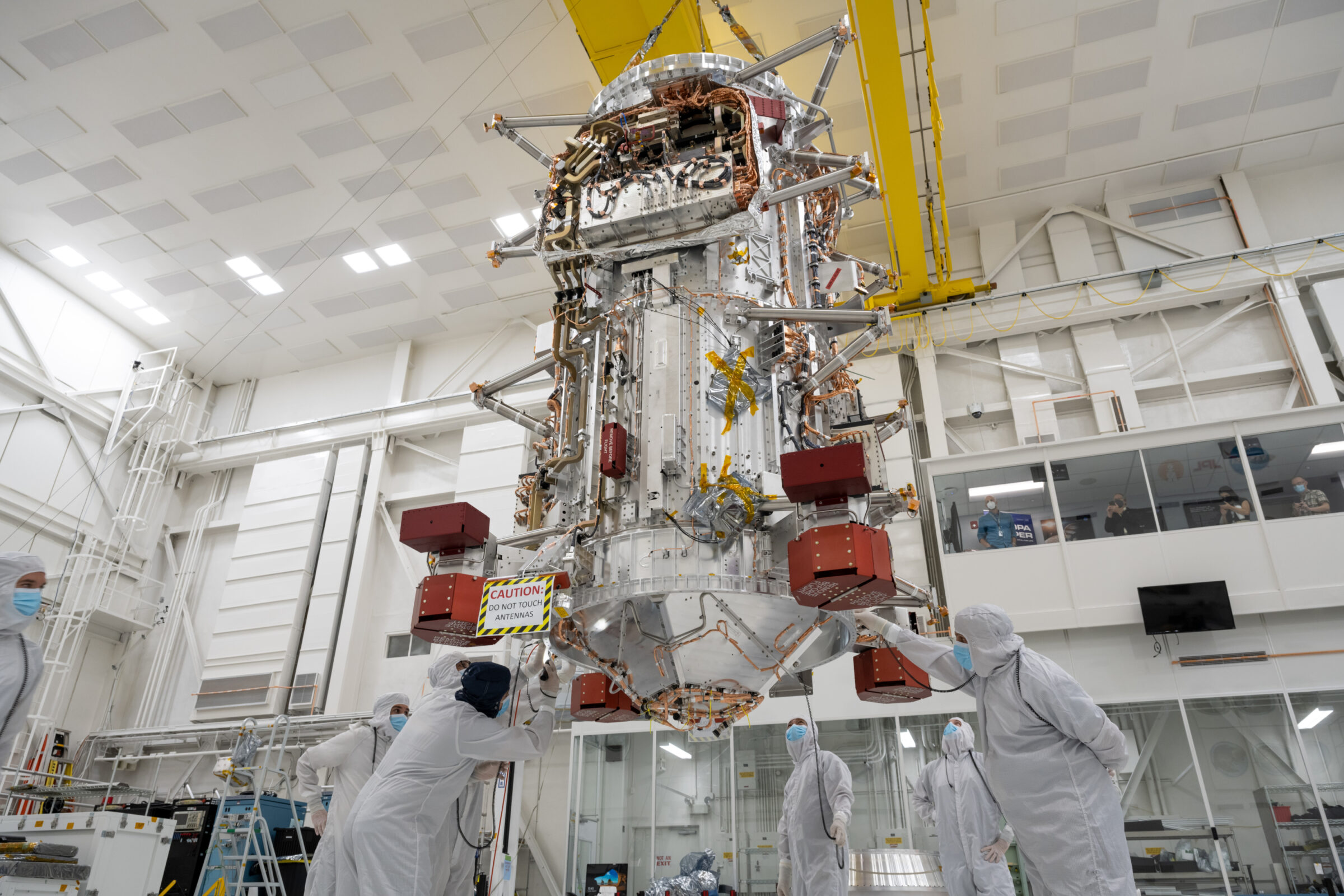The Downlink • Nov 08, 2024
Streaks and highlights
Space Snapshot

This past year, we’ve seen some amazing things in space science and exploration. With exciting launches, groundbreaking discoveries, and some awe-inspiring moments that brought space down to Earth, there has been a lot to enjoy and appreciate. What are the highlights for you?
The Planetary Society is kicking off our Best of 2024 campaign where you can vote for your favorite exploration milestones, images, missions, and more! Voting runs through November, and we’ll announce the winners in December.
Pictured: The tiny moon Phobos seems to hang above Mars in this image, taken in July by ESA’s Mars Express spacecraft. It’s one of the contenders for 2024’s best space exploration image. Image credit: ESA et al.
Fact Worth Sharing

Phobos orbits so close to Mars that when an asteroid impacts the planet, the debris from the collision sometimes reaches the little moon. Scientists think this might be what causes the streaks on Phobos’ leading side.
Mission Briefings


New images of the Vega star system suggest it has no large planets. Imaging data from the Hubble Space Telescope and JWST (pictured) suggest that the disk of small particles surrounding the nearby star Vega is smooth, without gaps produced by planets clearing their orbits. This makes Vega different from other stars observed this way, shedding light on the diversity of star systems. Image credit: NASA/ESA/CSA et al.

NEOWISE has burned up in the atmosphere, but its impact is far from over. NASA’s NEOWISE asteroid-hunting spacecraft reentered Earth’s atmosphere last Friday as expected. The spacecraft began as the WISE astrophysics mission in 2009 and shifted to searching for asteroids in 2013. During that time it mapped the entire sky at infrared wavelengths, providing data that could continue yielding discoveries for years to come.

VIPER has passed all pre-launch tests, but it’s unclear whether it will get to launch. The NASA mission to map water on the Moon’s south pole was canceled in July because the agency was concerned about potential future cost overruns. The rover is completely built, however, and recently passed all three of the required pre-launch tests. NASA has invited other organizations to submit proposals to take over the program.

Mars may have remained habitable for longer than we thought. A new study from researchers at Harvard University has suggested that the planet’s magnetic field, which protected the thick atmosphere and thereby made stable bodies of liquid water possible on its surface, may have survived until about 3.9 billion years ago. This is hundreds of millions of years longer than previous estimates of 4.1 billion years ago.

ISRO is delaying its first astronaut launch to 2026. The India Space Research Organization announced last week that it will delay the first crewed launch of its Gaganyaan human spaceflight program to ensure crew safety. ISRO still plans to conduct test flights this year, including sending a humanoid robot to low Earth orbit in December. If the Gaganyaan program succeeds, it will make India the fourth country to independently launch humans into space, after the United States, Russia, and China.
From The Planetary Society


Canada is entering the commercial launch market. Canada has been involved in space exploration since the earliest days of the space age, but the nation's space activities still have room to grow. This week on Planetary Radio, learn about Spaceport Nova Scotia, Canada’s first commercial launch site, and the significant step forward for the Canadian space industry that it represents. Pictured: The International Space Station's robotic Canadarm2, a contribution from the Canadian Space Agency. Image credit: Tim Peake/ESA/NASA.

NASA’s future direction is unclear, according to an expert. Norm Augustine, a distinguished aerospace industry veteran behind numerous influential studies, joins Planetary Radio: Space Policy Edition to discuss his new report, “NASA at a Crossroads,” which raises alarm bells about NASA’s workforce, infrastructure, and technology capabilities. Augustine has proposed solutions to these problems, but whether and how those solutions are implemented is yet to be seen.

This year’s International Observe the Moon Night broke records. The NASA-led, global event in September invited people from around the world to organize and take part in events celebrating all things lunar, from science to observing to cultural appreciation and more. This year, an estimated 1.3 million people took part, with nearly 1,500 public and private events and over 5,000 individual and household observers registering their activities.
⚠️Monthly members: Action needed!⚠️
The Planetary Society is upgrading our membership management system and our credit card charging processor has changed. For many monthly members, the process happens automatically and you won’t notice any changes to your monthly payment process. For others, however, these changes will require us to have members update their credit/debit card information.
To facilitate this, we are sending emails to those who need to update their credit card information with a unique link to a webpage where you can quickly enter your payment information. If you passed by the email and didn’t follow the prompt, you can quickly find it again by searching a Planetary Society email with the subject line “Action required re: your membership.” Please note that if you don’t update your information, your membership will lapse and you will lose access to your benefits. So, please be sure to update your information without delay!
Questions?
If you have questions regarding our new systems or the update process, you can learn more on the upgrade page and our FAQ page, or email us at [email protected]. You may also call us at (626) 793-5100, Monday through Friday, 12 p.m. to 7 p.m. ET.
What's Up

In the early evening, look for super bright Venus setting in the west and bright Jupiter rising in the east, with Saturn shining a bit higher in the southeastern sky. Later in the evening, Mars rises in the east. On Nov. 10, Saturn and the Moon will be very close together. Find out what to look forward to in our guide to November’s night skies.
Help save space missions. Join today!

If you are not already a member, we need your help. NASA is at a crossroads, and your support is needed today! Funding for space science and exploration is not guaranteed. It requires the voice of passionate advocates like you.
NASA is facing major budget cuts for the first time in a decade, and thousands of skilled scientists, engineers, and technicians have already been laid off at NASA centers across the US. NASA funding must grow, not shrink, if the agency is to succeed in returning to the Moon, exploring the Solar System, and seeking out life beyond Earth.
We must prevent future budget cuts. When you become a member of The Planetary Society, you join the world’s largest and most influential space advocacy nonprofit. Will you join us and enable the future of space exploration?
Wow of the Week

Tomorrow, Nov. 9, would have been the 90th birthday of Planetary Society co-founder and science communicator extraordinaire Carl Sagan. Carl’s impact on the world was profound, thanks in large part to his enlightened perspectives on the Cosmos, humanity’s exploration of it, and our own existence here on Earth. To this day, Carl’s birthday is celebrated around the world as Carl Sagan Day, with all kinds of events celebrating his life and legacy, science and exploration, and the joy of discovery. Pictured: Carl standing beside a scale model of NASA's Viking Mars lander in Death Valley, California. Image credit: NASA/JPL.
Send us your artwork!
We love to feature space artwork in the Downlink. If you create any kind of space-related art, we invite you to send it to us by replying to any Downlink email or writing to [email protected]. Please let us know in your email if you’re a Planetary Society member!


 Explore Worlds
Explore Worlds Find Life
Find Life Defend Earth
Defend Earth

